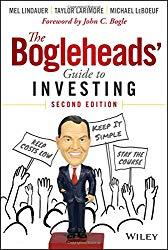People who know what they’re talking about when it comes to investing will tell you to invest in mutual funds, specifically index mutual funds because of their low cost. To learn how to invest with index mutual funds, which should be the core of your holdings and all of your retirement savings, pick up a copy of The Bogleheads’ Guide to Investing. This book will go into a lot of the details behind how mutual funds work and why you should buy certain types of funds (index funds). It also gives great advice on things like life insurance. Note, if you buy a copy by clicking on the book cover below and going through Amazon, it won’t cost you anything more than it would if you bought it elsewhere, but I’ll get a couple of dollars from Amazon. If I get enough of these commissions, it keeps me wanting to write more great articles like this one instead of going fishing, so it is really in your best interest too if you like good free web content. Just saying.

But once you’ve taken care of the basics – a fully-funded 401k and/or IRA loaded up with mutual funds for retirement – adding individual stocks can make sense. Despite what you will be told about mutual fund managers picking stocks not doing as well as the average index mutual fund, there are individuals – plenty of them – who do beat the markets and amass a small fortune with individual stocks. And there is a good reason for this: A mutual fund manager needs to buy many different stocks because he has a lot of money to invest, plus he needs to perform well every quarter or lose investors who go elsewhere chasing the next hot fund. An individual, conversely, can both concentrate positions and wait until her stocks start to perform. Both of these factors are key to doing well in individual stock investing.
The fact is, the guy or gal who beats the markets and uses proceeds from his stock investment to pay for a new home or his kid’s college education doesn’t do it by buying and selling a bunch of different stocks, making $1000 here and $500 there. He buys a big position and then holds it for decades, turning an initial $20,000 investment into $500,000 or more. How many $1000 gains would you need to make $480,000 over a couple of decades? You would need to make 480 of them, or about 24 of them per year consistently over a 20-year period, to match the gain someone who buys a great company and holds onto it while it grows and expands can do. And that doesn’t even count losses along the way (because you aren’t going to have 24 successful trades a year without having some losers).
It also doesn’t include the taxes you’ll pay for all of those short-term trades. If you’re jumping in and out of the markets, you’ll pay a higher tax rate than you will if you buy and hold for a few years because taxes are higher on short-term gains than long-term gains. Plus, you’ll be paying taxes (and brokerage commissions) all the time if you’re trading stocks frequently. If you hold for a long time, you won’t pay any taxes until you sell years later and you’ll only pay brokerage commissions when you first buy and when you sell at the end. This means that you’ll have extra money invested to grow and reinvest rather than having a constant suck from your portfolio out to Uncle Sam and the brokerage house. If you’re not in the US, you might have some really high tax rates to deal with, so minimizing taxes is key. Sometimes you can even play tricks like giving the stock to a child and then having them sell it at a lower tax rate, or giving the stock away to charity and pay no taxes. If you want to leave money to heirs, your capital gains are erased when you die (up to a certain amount), so you’ll never need to pay taxes on your gains if you just leave the money invested.
Instead of jumping in and out of stocks, I recommend a method I call serious investing, which is discussed in detail in my first book,
SmallIvy Book of Investing: Book 1: Investing to Become Wealthy

Typically, before I started doing serious investing, I would buy 100 shares of each company and have maybe ten to twenty companies in which I invested. I would buy at least 100 shares since I was using a full-service broker and the commission would be less when you bought in “round lots” of 100 shares since that made it easier for them to find a seller on the other side of the trade. (If you bought 75 shares, say, they would need to find someone selling 100 shares, since others were selling in round lots, and then sell you 75 of them and find something to do with the other 25 shares.) This made the percentage I was paying in commissions lower. For example, if I bought 100 shares of a $20 stock, the commission might be $75. If I bought 50 shares of the same stock, the commission might be $50. That would mean I would be paying about 3.8% commission when I bought more shares and a round lot, versus 5% commissions when I was buying fewer shares and an odd lot (opposite of a round lot). If I got lucky and the stock went up by 10 points, I would make $1000, minus commissions and taxes. I would spend a lot of time listing my stock sales on my taxes since I would typically have 20 trades or more each year.
In serious investing, you take up large positions in a few great stocks, rather than investing a little here and a little there. You find a few stocks (3 to start) and start building up positions in those stocks until you have perhaps 500-1000 shares. For example, if I like stock XYZ and it is trading at $15 per share, I might start out by buying 200 shares for $3000. I would then build up more cash and buy more shares a month or two later. Hopefully, the stock had fallen a little so that I could get more shares at a lower price. For example, if it fell to $12, I could then pick up another 200 shares for $2400, bring my cost basis (average price paid per share) down to about $13.50 per share. I would continue to do this until I had about 500-1000 shares in XYZ, then let it ride. Now, if I have 1000 shares and a stock rises by $10 per share, I would make $10,000. Have it go up $50 per share, and I make $50,000. Serious money. If the position gets too big or there is something I need to buy, I sell off a few shares and trim the position back. Hopefully, the stock will split once or twice along the way to make selling off a portion easier. Sell decisions are based upon my ability to sustain a loss should the stock fall to $0 and my need for cash, not based on what my profit is. I will also sell if the company has changed fundamentally and no longer a best-in-breed for its industry.
If, instead of just picking just one stock to concentrate on, I picked three different stocks, I could then buy whichever one was the best bargain at the time. If one shot up and started to look somewhat expensive, while another stock had fallen a bit and was starting to look cheap, I would buy additional shares of the cheaper stock. I would pick what I thought was the best stock in three different industries so that I had a chance of being invested in at least one industry that was doing well at any given time. For example, I might pick my favorite in the restaurant, home building, and internet industries.
Have a burning investing question you’d like answered? Please send to [email protected] or leave in a comment.
Follow on Twitter to get news about new articles. @SmallIvy_SI
Disclaimer: This blog is not meant to give financial planning or tax advice. It gives general information on investment strategy, picking stocks, and generally managing money to build wealth. It is not a solicitation to buy or sell stocks or any security. Financial planning advice should be sought from a certified financial planner, which the author is not. Tax advice should be sought from a CPA. All investments involve risk and the reader as urged to consider risks carefully and seek the advice of experts if needed before investing.
